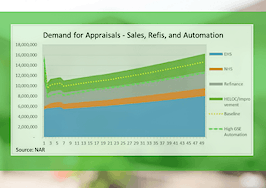- BuildZoom's chief economist asked, “Where does an increasing willingness to pay for housing fail to result in more housing being built?”
- Based on that metric, it's tougher to build in Honolulu and Los Angeles than in San Francisco or New York.
How do you quantify how difficult it is for developers to break ground (and finish) a new building in a given city?
When Issi Romem, chief economist at BuildZoom (an online remodeling marketplace), was asked to help a reporter at The Wall Street Journal find the toughest places to build in the country, he realized that looking at the locales that are slow to permit projects or don’t issue as many permits for projects probably wasn’t a good way to crunch these numbers.
Why? “There’s a selection issue,” he explained. “In the places where it’s toughest to build, developers aren’t going to submit a lot of permits. Developers know what’s likely to be feasible, and they don’t try things that are likely infeasible from the start.”
He outlined the process for putting his research together in a blog post, “The toughest places to build: Behind the scenes of a Wall Street Journal analysis,” and discussed the results with Inman.
“A better way to gauge the toughest places to build is to ask, ‘Where does an increasing willingness to pay for housing fail to result in more housing being built?'” Romem wrote in the post.
The toughest places to build
By that metric, Honolulu is the toughest place to build in the U.S., followed by Los Angeles. San Francisco and New York make the list, of course, but former two cities beat them out.
“I would never have ventured to guess that Houston and Denver would be roughly on par, or that Houston would be tougher to build in than Dallas and Austin,” Romem added.
In the blog post, he also noted that:
- Downtowns aren’t really tough places to build. “It is expected and accepted that U.S. downtowns be dense, and once density is accepted in an area it is easy to build more there,” he wrote.
- The inner suburbs, however, are a different story. Most suburbs have stricter rules about how tall buildings can be, among other restrictions, and the inner suburbs “are more likely to have depleted their supply of vacant lots, leaving no room for ‘acceptable’ new construction,” Romem wrote. “The three toughest-to-build neighborhoods featured in The Wall Street Journal — Venice Beach in Southern California (90291), Prospect-Lefferts Gardens in Brooklyn (11225) and the Fishtown section of Philadelphia (19125) — all fall into this category.”
- Gentrifying neighborhoods are typically where it’s toughest to build. “While the process of gentrification is in progress, neighborhoods experience sharp housing price appreciation,” Romem explained. “However, because gentrification is often closely tied to the neighborhood’s physical charm, housing price appreciation is rarely met by equally large increases in the rate of new construction. As a result, gentrifying neighborhoods often elicit an increasing willingness to pay for housing while failing to get more housing built.” He noted that Venice Beach, Prospect-Lefferts Gardens and Fishtown also fall into the “gentrifying” category.
- “Another variety of tough-to-build places consists of exclusive and wealthy low-density enclaves,” Romem added. In metro areas like Houston or Atlanta, which continue to sprawl outward from the city centers, “gentrification is less common and the sharpest housing price appreciation often occurs in exclusive, wealthy enclaves,” he wrote.
And there are also some metros that still have “legacy” housing supplies that exceed current demand. These include Detroit, Cleveland, Pittsburgh, Buffalo and New Orleans.
Methodology
Romem told Inman that the results are “rough,” and should therefore be “taken with a grain of salt” — but they’re illuminating nonetheless.
BuildZoom used U.S. Census and American Community Survey data to calculate housing units; Federal Housing Finance Agency research to figure housing price changes; and Census data to determine the 50 largest metro areas. It drew data for housing price levels “used in identifying metros in which housing supply exceeds current demand,” from Zillow.
Romem then plotted the percent change in housing units against the percent change in housing prices for the top 50 U.S. metros (plus Honolulu — the toughest place to build) by population.
“Metros with a smaller change in quantity relative to the change in price are taken to be tougher-to-build,” Romem explained in the blog post (which also contains metro and ZIP code data files for perusal if you’re interested).
So you’re operating in a tough place to build — what can be done?
“From an overarching perspective — what’s good for society and what’s good for equality in our future in general — I would love to see metro areas that are tough to build start densifying and learn to provide more housing within the existing footprint,” Romem told Inman. “That would potentially change the patterns we see.
“The odds are not in favor of that happening; it’s an uphill battle for the YIMBY [“Yes, in my backyard!”] movement to succeed,” he added. “What that means is, if you’re a Realtor in a city that has a downtown surrounded by a ring of suburbs that have seen price increases, but you are not seeing increases in density, those places are likely to continue along this trend. They’re going to remain places that draw a lot of demand and willingness to pay, but unless they’re willing to start engaging with redevelopment, they’re not going to increase their housing supply.”
He also noted that in the inner suburbs, “vacant lots have all been built on, and there’s no empty land. Those places are good bets for clients who want to get their money’s worth in the 20-30 year timeframe, unless there is a move toward densification — those high-demand inner suburbs that are just far enough from downtown that no one is going to be willing to tear down existing structures and build larger ones.”









